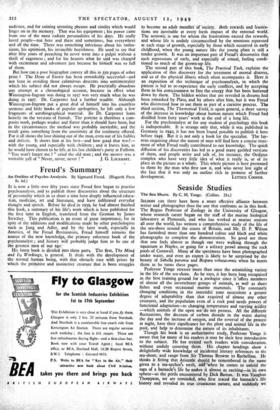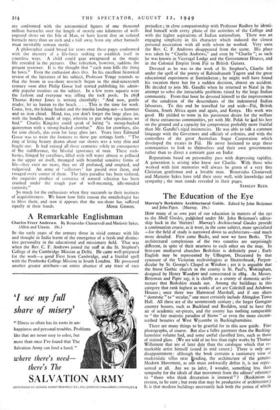Seaside Studies
The Sea Shore. By C. M. Yonge. (Collins. 21s.)
SELDOM can there have been a more effective alliance between writer and photographer than the one that confronts us in this book. The Regius Professor of Zoology in the University of Glasgow, whose research career began on the staff of the marine biological laboratory at Plymouth, and who has worked at marine stations all over the world, has written a comprehensive study of the life of the sea-shore around the coasts of Britain, and Mr. D. P. Wilson has furnished more than one hundred colour and black and white photographs to complete the demonstration. So good are these that one feels almost as though one were walking through the aquarium at Naples' or going for a solitary prowl among the rock pools of Cornwall. Many of the specimens have been photographed under water, and even an expert is likely to be surprised by the beauty of Sabena pavonia and Bispara volutacarnis when he meets them as he turns these pages.
Professor Yonge stresses more than once the astonishing variety in the life of the sea-shore. As he says, it has been long recognised as the best training ground for a zoologist since it 'offers members of almost all the invertebrate groups of animals, as well as shore fishes and even occasional marine mammals. The constantly changing conditions in the intertidal zone necessitate a greater degree of adaptability than that required of almost any other creatures, and the population even of a rock pool needs powers of functional adaptation—to changing temperature and varying acidity —which animals of the open sea do not possess. All the different fluctuations, the decrease of carbon dioxide in the water during the day and the increase of oxygen, and the reversal of the process at night, have their significance for the plant and animal life in the pool, and help to determine the nature of its inhabitants.
Though his book is an authoritative study, Professor Yonge is aware that for many of his readers it may be their first introduction to the subject. He has treated such readers with consideration, without unduly cosseting them. His chapter headings show a delightfully wide knowledge of incidental literary references to the sea-shore, and range from .Sir Thomas Browne to Barbellion. He thinks it fitting that Aristotle should be remembered in the name given to a sea-urchin's teeth, aziawhen he comes to unfold the saga of a barnacle's life he makes it almost as exciting—in its own sphere—as the perils encountered by Dick Barton. It was Vaughan Thompson, we are reminded, who first traced the barnacle's life history and revealed its true crustacean nature, and suddenly we
are confronted with the astronomical figures of one thousand million barnacles over the length of merely one kilometre of well- exposed shore on the Isle of Man, or have learnt that an isolated barnacle more than an inch and a half away from any other barnacle must inevitably remain sterile.
A philosopher could brood for years over these pages confronted with the mystery of a life-force seeking to establish itself in countless ways. A child could gaze enraptured at the magic life revealed in the pictures. One reflection, however, saddens the present reviewer. It is the thought that "each man kills the thing he loves." Even the enthusiast does this. In his excellent historical review of the literature of his subject, Professor Yongc reminds us that the boom in sea-shore research began in the mid-nineteenth century soon after Philip Gossc had started publishing his admir- able popular treatises on the subject. In a few years aquaria were the fashion and everyone was rifling the rock pools. In 1858 Thomas Rymer Jones is writing cheerfully: "And now, gentle reader, let us hasten to the beach. . . . This is the time for work. Come, boy, the fishing basket and the muslin landing-net—a hammer and an iron chisel. Mind, too, you don't forget the large glass jar, with the handles made of rope, wherein to put what specimens we find." Charles Kingsley could speak of hiring "a strong-backed quarryman with a strong-backed crowbar." Alas for crowbars, alas for iron chisels, alas even for large glass jars. Years later Edmund Gossc was to write the footnote to these gay settings forth : "The ring of living beauty drawn about our shores was a very thin and fragile one. It had existed all those centuries solely in consequence of the indifference, the blissful ignorance of man. These rock- basins, fringed by corallines, filled with still water almost as pellucid as the upper air itself, thronged with beautiful sensitive forms of life—they exist no more, they are all profaned, and emptied, and vulgarised. An army of ' collectors ' has passed over them, and ravaged every corner of them. The fairy paradise has been violated, the exquisite product of centuries of natural selection has been crushed under the rough paw of well-meaning, idle-minded curiosity."
o much for the enthusiasts when they succumb to their instincts of acquisitiveness. We know how little reason the ornithologist has to bless them, and now it appears that the sea-shore has suffered































 Previous page
Previous page